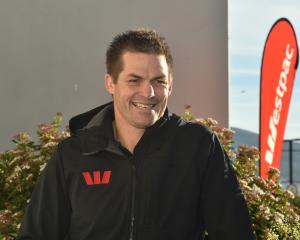
Yes, it is an actual word; "an act, addition or quality that makes something more stylish, lively or attractive", according to Google.
And it’s that zhuzh that gets the Dunedin-based civil designer out of bed in the morning and has done for nearly 50 years.
In a year in which Mr Thomson will be turning 65, he started thinking about how he could "make a difference" during his last few pre-retirement years at Stantec.
There were skills amassed over that career that he felt he needed to pass on to others, particularly the cadets taken on by Stantec — just as he was hired all those years ago — along with delivering an injection of "that little bit of passion" he also had to deliver.
"There’s no substitute for experience. Succession planning for me is about transferring some of the skills I have amassed over 47 years on to the young folk. They are the people who are going to carry the business forward," he said.
Mr Thomson grew up in Balclutha, and particularly enjoyed technical drawing as a subject at South Otago High School.
A trip to Dunedin and a visit to the Ministry of Works (MOW), where he saw all the drawings and what staff were doing, was to prove a pivotal moment.
"I thought, ‘that’s what I want to do’. I’ve never wanted to do anything else ever since," he said.
Leaving school at the end of his sixth-form (year 12) year, he went straight to MOW as a cadet and remained there for 12 years.
He was desperate not to go to university, but had to convince his principal that the pathway he was on would lead him to going to university.
"He thought that life in a draughting office was too mundane and I’d get sick of it and want something more," he recalled.
Work had been varied; from lots of bridges to working on the likes of the Maniototo and Lower Waitaki irrigation schemes.
When a big chunk of the Outram Bridge was removed by the Taieri flood in 1980 — unknown in the dark to the truck driver who attempted to drive over it, causing the truck to belly flop into the Taieri River — it was Mr Thomson’s drawings that led to it being put back together again.
The past 36 years had been spent at Stantec and he was still learning something new every day, he said.
His position had changed over the years; originally he was a draughtsman on the board, now he was more aptly described as a civil designer. That change had come about via the software the business used.
Those skills he felt he needed to pass on included programming the software, so he started a lunchtime programming school.
While he was teaching software, he was also teaching his learners the underlying civil engineering he wanted them to understand.
He also discussed with his boss a role change to mentor, or "hoverer", to ensure that good thought had gone into programme planning, that the digital set-up was appropriate and staff had understood the best way to approach the digital design process.
Among the lessons he wanted to impart was that even a cadet could play a significant role in the development of a design, just by asking questions.
He implored them to ask lots of questions, especially directed at those with experience, and told them they would be amazed at what their colleagues were prepared to share.
Critical thinking was required — "don’t just draw what you are given. Make sure you understand it first, then you are equipped to ask probing questions" — and they needed to take their time and plan a strategy for design.
And when it came to design, he also encouraged young people to design their own careers.
"Everyone has to start somewhere and not all parts of the job are the exciting bits, so learn as much as you can and find the parts of the work that you are passionate about.
"Mould your career around those areas that you really enjoy. This way you will be motivated to be really good at it. Then every morning when you think about going to work, it is more like going out to play.
"Tell your boss about what gives you your zhuzh. They will certainly be keen to support you in the work mode that you can really make a difference in," he said.












